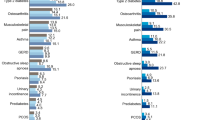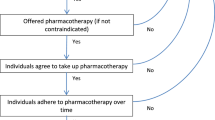Abstract
Objective:
The purpose of this study was to ascertain the impact of obesity on the cost of disease management in people with or at high risk of atherothrombotic disease from a governmental perspective using a bottom-up approach to cost estimation. In addition, the aim was also to explore the causes of any differences found.
Method:
The health-care costs of obesity were estimated from 2819 participants recruited into the nationwide Australian REACH Registry with established atherothrombotic disease or at least three risk factors for atherothrombosis. Enrollment was in 2004, through primary care general practices. Information was collected on the use of cardiovascular drugs, hospitalizations and ambulatory care services. ‘Bottom-up’ costing was undertaken by assigning unit costs to each health-care item, based on Australian Government-reimbursed figures 2006–2007. Linear-mixed models were used to estimate associations between direct medical costs and body mass index (BMI) categories.
Results:
Annual pharmaceutical costs per person increased with increasing BMI category, even after adjusting for gender, age, living place, formal education, smoking status, hypertension and diabetes. Adjusted annual pharmaceutical costs of overweight and obese participants were higher ($7 (P=0.004) and $144 (<0.001), respectively) than those of the normal weight participants. This was due to participants in higher BMI categories receiving more pharmaceuticals than normal weight participants. There was no significant change across the BMI categories in annual ambulatory care costs and annual hospital costs.
Conclusion:
In these participants with or at high risk of atherothrombotic disease, annual pharmaceutical costs were greater in participants of higher BMI category, but there was not such a gradient in the annual hospital or ambulatory care costs. The greater cardiovascular pharmaceutical costs for participants of higher BMI categories remained even after adjusting for a range of demographic factors and comorbidities. Our results suggest that these costs are explained by the higher number of drugs used among people with atherothrombotic disease. Further investigation is needed to understand the reasons for this level of drug use.
This is a preview of subscription content, access via your institution
Access options
Subscribe to this journal
Receive 12 print issues and online access
$259.00 per year
only $21.58 per issue
Buy this article
- Purchase on Springer Link
- Instant access to full article PDF
Prices may be subject to local taxes which are calculated during checkout

Similar content being viewed by others
References
Raebel MA, Malone DC, Conner DA, Xu S, Porter JA, Lanty FA . Health services use and health care costs of obese and nonobese individuals. Arch Intern Med 2004; 164: 2135–2140.
McCormick I, Stone I . Economic costs of obesity and the case for government intervention. Obes Rev 2007; 8 (Suppl 1): 161–164.
Thompson D, Brown J, Nichols G, Elmer P, Oster G . Body mass index and future healthcare costs: a retrospective cohort study. Obes Res 2001; 9: 210–218.
Thompson D, Wolf AM . The medical-care cost burden of obesity. Obes Rev 2001; 2: 189–197.
Quesenberry Jr CP, Caan B, Jacobson A . Obesity, health services use, and health care costs among members of a health maintenance organization. Arch Intern Med 1998; 158: 466–472.
Kuriyama S, Tsuji I, Ohkubo T, Anzai Y, Takahashi K, Watanabe Y et al. Medical care expenditure associated with body mass index in Japan: the Ohsaki Study. Int J Obes 2002; 26: 1069–1074.
Allender S, Rayner M . The burden of overweight and obesity-related ill health in the UK Sep. Obes Rev 2007; 8: 467–473.
Access Economics 2006. The Economic Costs of Obesity. Report to Diabetes Australia. Available through: http://www.accesseconomics.com.au/publicationsreports/reports.php. (accessed 2 February 2009).
Narbro K, Agren G, Jonsson E, Naslund I, Sjostrom L, Peltonen M . Pharmaceutical costs in obese individuals: comparison with a randomly selected population sample and long-term changes after conventional and surgical treatment: the SOS intervention study. Arch Intern Med 2002; 162: 2061–2069.
Finkelstein EA, Brown JB, Trogdon JG, Segel JE, Ben-Joseph RH . Age specific impact of obesity on prevalence and costs of diabetes and dyslipidemia. Value Health 2007; 10: S45–S51.
Ohman EM, Bhatt DL, Steg PG, Goto S, Hirsch AT, Liau CS et al. The reduction of atherothrombosis for continued health (REACH) registry: an international, prospective, observational investigation in subjects at risk for atherothrombotic events-study design. Am Heart J 2006; 151: 786, e1-e10.
Bhatt DL, Steg PG, Ohman EM, Hirsch AT, Ikeda Y, Mas JL et al. International prevalence, recognition, and treatment of cardiovascular risk factors in outpatients with atherothrombosis. JAMA 2006; 295: 180–189.
Reid C, Nelson MR, Shiel L, Chew D, Connor G, DeLooze F . Australians at risk: management of cardiovascular risk factors in the REACH Registry. Heart Lung Circ 2008; 17: 114–118.
Prospective Studies Collaboration. Body-mass index and cause-specific mortality in 900 000 adults: collaborative analyses of 57 prospective studies. Lancet 2009; 373: 1083–1096.
Ademi Z, Liew D, Chew D, Conner G, Shiel L, Nelson MR et al. Drug treatment and cost of cardiovascular in Australia. Cardiovasc Ther 2009; 27: 164–172.
Chapko M, Liu C, Perkins M, Li Y, Fortney J, Maciejewski M . Equivalence of two healthcare costing methods: bottom-up and top-down. Health Econ 2008; 18: 1188–1201.
Pharmaceutical Benefits Schedule Item Reports. Period September 2006 to September 2007. Available from: https://www.medicareaustralia.gov.au/statistics/pbs_item.shtml. (accessed 2 February 2009).
Ademi Z, Liew D, Chew D, Conner G, Shiel L, Nelson MR et al. Predictors of annual pharmaceutical costs in Australia for participants with or at high risk of cardiovascular disease. Am J Cardiovasc Drugs 2010; 2: 1–10.
Duckett SJ . The Australian Health Care System, 3rd edn. Oxford University Press: South Melbourne, Victoria, 2007.
Casemix view. http://www.sma.org.sg/sma_news/3202/report.pdf (accessed 19 December 2009).
Duckett SJ . Casemix funding for acute hospital inpatient services in Australia. Med J Aust 1998; 169: S17–S21.
Medicare Benefits Schedule Book. Australian Government Department of Health and Ageing. November 2007. Available from: http://www.health.gov.au/internet/mbsonline/publishing.nsf/Content/D25CFA71D62D2439CA2574F9002B42CD/$File/2007-11-CLACP.pdf. (accessed 11 April 2009).
Medicare Australia. Available from: http://www.medicareaustralia.gov.au/. (accessed 11 April 2009).
Hauck K, Hollingsworth B . Do obese patients stay longer in hospital? Estimating the health care costs of obesity. Centre for Health Economics Research Paper 2008. Available through: http://www.buseco.monash.edu.au/centres/che/pubs/rp028.pdf.
Senes S, Penm E . Australian Institute of Health and Welfare. Medicines for cardiovascular health: are they used appropriately? Cardiovascular disease series no. 27. Cat. no. 36. AIHW: Canberra, 2007.
Access Economics. The shifting burden of cardiovascular disease in Australia. National Heart Foundation of Australia: Canberra, 2005.
Acknowledgements
The global REACH Registry is sponsored by sanofi-aventis, Bristol-Myers Squibb, and the Waksman Foundation (Tokyo, Japan), and is endorsed by the World Heart Federation. The REACH Registry enforces a no-ghostwriting policy. A complete list of global REACH investigators is available at www.reachregistry.org. This work was supported by Monash University. In addition, this work was supported in part by the Australian Research Council Linkage Project LP077532, National Health and Medical Research Council grant (No. 465130).
Author information
Authors and Affiliations
Consortia
Corresponding author
Ethics declarations
Competing interests
Zanfina Ademi, Helen Walls, Anna Peteers, Danny Liew, Bruce Hollingsworth, Christopher Stevenson and Christopher Reid declare no conflict of interest. Ph Gabriel Steg has the following disclosures: research grant from sanofi-aventis. Speakers bureau: Boehringer-Ingelheim, Bristol-Myers Squibb, GlaxoSmithKline, Medtronic, Nycomed, sanofi-aventis, Servier. Consulting/advisory board: Astellas, AstraZeneca, Bayer, Boehringer-Ingelheim, Bristol-Myers Squibb, Endotis, GlaxoSmithKline, Medtronic, MSD, Nycomed, sanofi-aventis, Servier, The Medicines Company. Deepak L Bhatt has received research grants from sanofi-aventis and Bristol-Myers Squibb who have funded the REACH Registry. He has also received institutional research support from AstraZeneca, Eisai, Ethicon, Heartscape and The Medicines Company.
Appendices
Appendix 1
Appendix 2
Appendix 3
Rights and permissions
About this article
Cite this article
Ademi, Z., Walls, H., Peeters, A. et al. Economic implications of obesity among people with atherothrombotic disease. Int J Obes 34, 1284–1292 (2010). https://doi.org/10.1038/ijo.2010.42
Received:
Revised:
Accepted:
Published:
Issue Date:
DOI: https://doi.org/10.1038/ijo.2010.42



